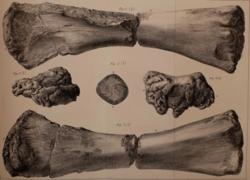Biology:Ischyrosaurus
| Ischyrosaurus | |
|---|---|

| |
| Humerus in multiple views | |
| Scientific classification Error creating thumbnail: Unable to save thumbnail to destination
| |
| Domain: | Eukaryota |
| Kingdom: | Animalia |
| Phylum: | Chordata |
| Clade: | Dinosauria |
| Clade: | Saurischia |
| Clade: | †Sauropodomorpha |
| Clade: | †Sauropoda |
| Genus: | †Ischyrosaurus Hulke, 1874 |
| Type species | |
| †Ischyrosaurus manseli Hulke, 1874
| |
"Ischyrosaurus" (meaning "strong lizard", for its large humerus; name in quotation marks because it is preoccupied) was a genus of sauropod dinosaur from the Kimmeridgian-age Upper Jurassic Kimmeridge Clay of Dorset, England .
History and taxonomy
"Ischyrosaurus" is based on a partial humerus (NHMUK R41626) found in 1868.[1] John Hulke described it briefly in 1869,[1] then named it in 1874.[2] The genus is preoccupied by a name Edward Drinker Cope coined in 1869.
Like most sauropod remains from the Upper Jurassic-Lower Cretaceous of Europe, it was initially synonymized with Ornithopsis to create the new combination O. manseli,[3] then with Pelorosaurus as P. manseli.[4][5][6] Upchurch et al., in their review of sauropods (2004), listed it as a dubious sauropod.[7] A 2010 overview of Late Jurassic sauropods from Dorset noted that "Ischyrosaurus" shared features seen in both Rebbachisauridae and Titanosauriformes, but lacked features to nail down its exact phylogenetic position.[8]
Paleobiology
As a sauropod, it would have been a large quadrupedal herbivore.[7]
References
- ↑ 1.0 1.1 Hulke, J. W. (1869). "Note on a large Saurian Humerus from the Kimmeridge Clay of the Dorset Coast". Quarterly Journal of the Geological Society 25 (1–2): 386–389. doi:10.1144/GSL.JGS.1869.025.01-02.66.
- ↑ Hulke, J. W. (1874). "Note on a very Large Saurian Limb-bone adapted for Progression upon Land, from the Kimmeridge Clay of Weymouth, Dorset". Quarterly Journal of the Geological Society 30 (1–4): 16–17. doi:10.1144/GSL.JGS.1874.030.01-04.17. https://zenodo.org/record/1448519/files/article.pdf.
- ↑ Lydekker, R. (1888). Catalogue of the Fossil Reptilia and Amphibia in the British Museum (Natural History). Part I. Containing the Orders Ornithosauria, Crocodilia, Dinosauria, Squamata, Rhynchocephalia, and Proterosauria. British Museum (Natural History):London, 1-309.
- ↑ von Huene, F. (1909). Skizze zu einer Systematik und Stammesgeschichte der Dinosaurier. Centralblatt für Mineralogie, Geologie und Paläontologie 1909:12-22. [German]
- ↑ Romer, A.S. (1956). Osteology of the Reptiles. University of Chicago Press:Chicago 1-772. ISBN:0-89464-985-X
- ↑ Steel, R. (1970). Part 14. Saurischia. Handbuch der Paläoherpetologie/Encyclopedia of Paleoherpetology. Part 14. Gustav Fischer Verlag:Stuttgart p. 1-87.
- ↑ 7.0 7.1 Upchurch, P.M., Barrett, P.M., and Dodson, P. (2004). Sauropoda. In: Weishampel, D.B., Dodson, P., and Osmólska, H. (eds.). The Dinosauria (2nd edition). University of California Press:Berkeley 259-322. ISBN:0-520-24209-2
- ↑ Paul M. Barrett, Roger B.J. Benson and Paul Upchurch (2010). "Dinosaurs of Dorset: Part II, the sauropod dinosaurs (Saurischia, Sauropoda) with additional comments on the theropods". Proceedings of the Dorset Natural History and Archaeological Society 131: 113–126.
Wikidata ☰ Q988061 entry

